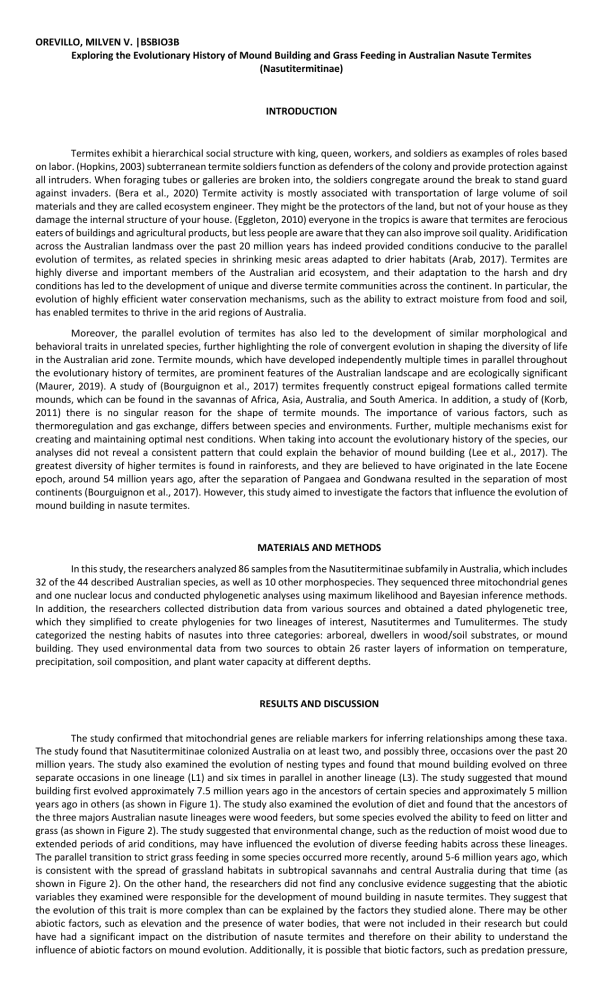Exploring the Evolutionary History of Mound Building and Grass Feeding in Australian Nasute Termites (Nasutitermitinae)
advertisement

OREVILLO, MILVEN V. |BSBIO3B Exploring the Evolutionary History of Mound Building and Grass Feeding in Australian Nasute Termites (Nasutitermitinae) INTRODUCTION Termites exhibit a hierarchical social structure with king, queen, workers, and soldiers as examples of roles based on labor. (Hopkins, 2003) subterranean termite soldiers function as defenders of the colony and provide protection against all intruders. When foraging tubes or galleries are broken into, the soldiers congregate around the break to stand guard against invaders. (Bera et al., 2020) Termite activity is mostly associated with transportation of large volume of soil materials and they are called ecosystem engineer. They might be the protectors of the land, but not of your house as they damage the internal structure of your house. (Eggleton, 2010) everyone in the tropics is aware that termites are ferocious eaters of buildings and agricultural products, but less people are aware that they can also improve soil quality. Aridification across the Australian landmass over the past 20 million years has indeed provided conditions conducive to the parallel evolution of termites, as related species in shrinking mesic areas adapted to drier habitats (Arab, 2017). Termites are highly diverse and important members of the Australian arid ecosystem, and their adaptation to the harsh and dry conditions has led to the development of unique and diverse termite communities across the continent. In particular, the evolution of highly efficient water conservation mechanisms, such as the ability to extract moisture from food and soil, has enabled termites to thrive in the arid regions of Australia. Moreover, the parallel evolution of termites has also led to the development of similar morphological and behavioral traits in unrelated species, further highlighting the role of convergent evolution in shaping the diversity of life in the Australian arid zone. Termite mounds, which have developed independently multiple times in parallel throughout the evolutionary history of termites, are prominent features of the Australian landscape and are ecologically significant (Maurer, 2019). A study of (Bourguignon et al., 2017) termites frequently construct epigeal formations called termite mounds, which can be found in the savannas of Africa, Asia, Australia, and South America. In addition, a study of (Korb, 2011) there is no singular reason for the shape of termite mounds. The importance of various factors, such as thermoregulation and gas exchange, differs between species and environments. Further, multiple mechanisms exist for creating and maintaining optimal nest conditions. When taking into account the evolutionary history of the species, our analyses did not reveal a consistent pattern that could explain the behavior of mound building (Lee et al., 2017). The greatest diversity of higher termites is found in rainforests, and they are believed to have originated in the late Eocene epoch, around 54 million years ago, after the separation of Pangaea and Gondwana resulted in the separation of most continents (Bourguignon et al., 2017). However, this study aimed to investigate the factors that influence the evolution of mound building in nasute termites. MATERIALS AND METHODS In this study, the researchers analyzed 86 samples from the Nasutitermitinae subfamily in Australia, which includes 32 of the 44 described Australian species, as well as 10 other morphospecies. They sequenced three mitochondrial genes and one nuclear locus and conducted phylogenetic analyses using maximum likelihood and Bayesian inference methods. In addition, the researchers collected distribution data from various sources and obtained a dated phylogenetic tree, which they simplified to create phylogenies for two lineages of interest, Nasutitermes and Tumulitermes. The study categorized the nesting habits of nasutes into three categories: arboreal, dwellers in wood/soil substrates, or mound building. They used environmental data from two sources to obtain 26 raster layers of information on temperature, precipitation, soil composition, and plant water capacity at different depths. RESULTS AND DISCUSSION The study confirmed that mitochondrial genes are reliable markers for inferring relationships among these taxa. The study found that Nasutitermitinae colonized Australia on at least two, and possibly three, occasions over the past 20 million years. The study also examined the evolution of nesting types and found that mound building evolved on three separate occasions in one lineage (L1) and six times in parallel in another lineage (L3). The study suggested that mound building first evolved approximately 7.5 million years ago in the ancestors of certain species and approximately 5 million years ago in others (as shown in Figure 1). The study also examined the evolution of diet and found that the ancestors of the three majors Australian nasute lineages were wood feeders, but some species evolved the ability to feed on litter and grass (as shown in Figure 2). The study suggested that environmental change, such as the reduction of moist wood due to extended periods of arid conditions, may have influenced the evolution of diverse feeding habits across these lineages. The parallel transition to strict grass feeding in some species occurred more recently, around 5-6 million years ago, which is consistent with the spread of grassland habitats in subtropical savannahs and central Australia during that time (as shown in Figure 2). On the other hand, the researchers did not find any conclusive evidence suggesting that the abiotic variables they examined were responsible for the development of mound building in nasute termites. They suggest that the evolution of this trait is more complex than can be explained by the factors they studied alone. There may be other abiotic factors, such as elevation and the presence of water bodies, that were not included in their research but could have had a significant impact on the distribution of nasute termites and therefore on their ability to understand the influence of abiotic factors on mound evolution. Additionally, it is possible that biotic factors, such as predation pressure, OREVILLO, MILVEN V. |BSBIO3B may have been the main selective pressure that led to mound building in nasute termites. Living in a mound provides a colony with several benefits, including the ability to support larger populations compared to single-piece wood nesting, food storage, and enhanced defense against predators. The researchers observed that the evolution of mound building may have allowed termites in lineage 1 to colonize a wider variety of niches and a larger area of the Australian continent. There is strong evidence for ecological speciation via niche divergence in Australian nasutes, with niches not being conserved over evolutionary time in any of these species. The nasutes appear to be able to colonize new niches easily, potentially leading to the cessation of gene flow from their parent lineage. Figure 1. Phylogenetic tree estimated in a Bayesian analysis of 1800 bp from mitochondrial 12S, 16S, and COX2 genes. Circles at nodes indicate posterior probabilities. Branch lengths are proportional to time, with the scale bar given in millions of years before present. Each of the three Australian lineages is indicated as L1–L3. Branch shading indicates the OREVILLO, MILVEN V. |BSBIO3B inferred geographical locations. Example mound and arboreal nests from selected species (a–f) are shown (photo credits:(a) Jan Šobotník, (b) Graham Chapman, (e) Neil Ross, (f) Aaron Stewart). (Online version in color.) (Arab et al., 2017) Figure 2. Reconstruction of ancestral nesting habits and diet for the clades containing Australian lineages L1–L3. The tree is based on the Bayesian estimate of the mitochondrial tree (figure 1); support values (shown) were generally high within each of these lineages. The tree was pruned so that only one sample of each putative species is represented. N., unclassified Nasutitermitinae. The ancestral dietary state of wood feeding in L3 is based on the wider analysis shown in the electronic supplementary material, figure S5. (Online version in color.) (Arab et al., 2017) OREVILLO, MILVEN V. |BSBIO3B Table 1. Area-under-the-curve values for the environmental niche models constructed in this study. (Beasley-hall et al., 2017) The study found that most of the examined species had high AUC values indicating good model performance. However, two species had AUC values of <0.80, (as shown in Table 1.), which may be due to insufficient occurrence data or broad predicted fundamental niches. Niche overlap was variable between lineages, with no overall directionality regarding niche overlap changing over evolutionary time. Logistic regression analyses found that the niches of all possible sister taxa differed significantly from each other, but the variables influencing these differences were not consistent. The percentage contribution analyses showed no clear trend in the types of variables influencing the models, although most species in lineage 2 were constrained by temperate-related variables above all others. The researchers performed ancestral niche reconstructions on internal nodes and 25 species to examine the influence of abiotic variables on mound-building behavior. They found no clear grouping of mound-building species with respect to climatic tolerances of any variable, suggesting a complex evolutionary history of this trait beyond abiotic influence. Mound builders did not display a positive or negative bias of tolerance compared with their sister taxa for any variable, and their tolerances did not group independently of arboreal or wood/soil nesting. These results indicate that the evolution of mound-building behavior may not be strongly influenced by environmental factors ( as shown in Figure 3.) below. Figure 3. Example ancestral niche reconstructions (ANRs) of Australian nasute lineages 1 and 2 concerning annual precipitation (‘BIO12’). The researcher found no evidence for any of the abiotic variables considered here being correlated with the parallel acquisition of mound building. The 80% central densities of climatic tolerance are denoted by dotted vertical lines. The nesting types for the species are coded at the tips as arboreal (A), wood/soil/other (W) or mound building (M). Species sharing the same-coloured branches are sister to one another. (Beasley-hall et al., 2017) CONCLUSION To conclude, the study highlights the ability of Nasutitermitinae termites in Australia to adapt and evolve in response to changing environments and climate. The termites evolved the ability to build mounds and feed on new substrates, contributing to their ecological success. The evolution of this trait is complex and cannot be solely attributed to abiotic factors, with biotic factors likely playing a crucial role. The shift from arboreal to epigeal nesting in the first lineage may have enabled the termites to colonize a wider area. Further genomic studies could uncover the genetic mechanisms behind dietary evolution and mound building. The study provides a unique example of parallel evolution across genera and highlights the predictable nature of evolution under certain ecological conditions. OREVILLO, MILVEN V. |BSBIO3B REFERENCES Arab, D. A., Namyatova, A., Evans, T. A., Cameron, S. L., Yeates, D. K., Ho, S. Y., & Lo, N. (2017). Parallel evolution of mound-building and grass-feeding in Australian nasute termites. Biology Letters, 13(2), 20160665. Beasley-Hall, P. G., Chui, J., Arab, D. A., & Lo, N. (2019). Evidence for a complex evolutionary history of mound building in the Australian nasute termites (Nasutitermitinae). Biological Journal of the Linnean Society, 126(2), 304-314. Bourguignon, T., Lo, N., Šobotník, J., Ho, S. Y., Iqbal, N., Coissac, E., ... & Evans, T. A. (2017). Mitochondrial phylogenomics resolves the global spread of higher termites, ecosystem engineers of the tropics. Molecular Biology and Evolution, 34(3), 589-597. Korb, J. (2011). Termite mound modern synthesis, 349-373. architecture, from function to construction. Biology Lee, T. R., Evans, T. A., Cameron, S. L., Hochuli, D. F., Ho, S. Y., & Lo, N. (2017). Ecological diversification of the Australian Coptotermes termites and the evolution of mound building. Journal of Biogeography, 44(6), 1405-1417. Maurer, S. S. (2019). The evolution of mound building in the Australian harvester termites, Drepanotermes (Doctoral dissertation, Institute of Zoology). of termites: a

